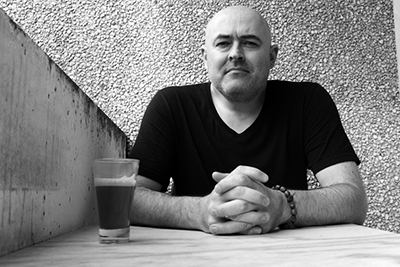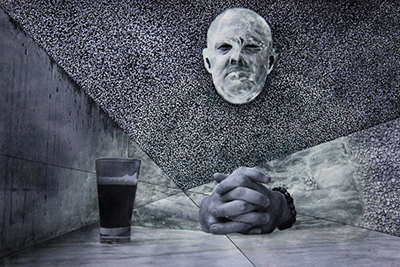Long term projects
I like to work in projects at long term, evolve with the situation, as a photographer i try to portray what is around me, use only the natural light available, and interfere as as less as possible with the action or situation. In my work is what you see (if) and what you read that counts.
Beneath the Serpent’s Spectrum
SkyScape Series
Concept:
City of London skyline seen from Hackney with the iconic buildings The Gherkin, Tower 42 and One Canada Square showcasing their iconic silhouettes as a city scape at the bottom of the photography and the rest of the image is used as a curtain back drop to portrait the changing London skies.
-

- Hackney. Tuesday 6 April 2004, 14:05 Low, brooding nimbostratus clouds roll ominously over Hackney in the early spring afternoon, casting a cinematic shadow across the cityscape and foreshadowing rain.
-

- Hackney. Wednesday 14 April 2004, 19:08 Hackney transitions into evening beneath a vast, cloudless sky, the city skyline glowing under the last light of day—a picture of calm as the sun sets in the distance.
-

- Hackney. Saturday 27 November 2003, 14:29 A solitary cumulus cloud, edged with light, drifts above Hackney in the early winter afternoon, brilliantly backlit by the sun and framed by a serene expanse of clear sky.
-

- Hackney. Friday 8 October 2004, 15:53 Towering cumulus congestus and dark nimbostratus clouds dramatically sweep over Hackney’s skyline on a crisp autumn afternoon, their imposing presence hinting at impending rain as sunlight fights to break through.
Concept:
Through the medium of time-lapse video, this project seeks to reveal the passage of time and the essence of weather as it unfolds across the Costa da Morte sky.
Location: Sofan. The central view frames the Atlantic Ocean, Cape Finisterre, and the sprawling Carnota beach. To the left, viewers can see the Portocubelo pier, while Monte Pindo and Caldebarcos form the rugged right side of the landscape.
Land Art
The Oma Forest, or Painted Forest, is one of the most emblematic works of land art by Agustín Ibarrola. He began painting the trees near his house in Kortezubi (Bizkaia) in 1982 and it took him three years of work to paint nearly 500 pine trees to create the three-dimensional compositions that make up the original work. He painted directly on the bark of pine trees, using the surface of the trees as a canvas. He worked with a brush and a ladder, painting tree by tree to complete the compositions. He used intense colors to create figures, lines, circles and geometric shapes on the trunks. He played with perspective and different planes of depth, distributing the figures between different trees to create three-dimensional compositions. He broke the law of traditional perspective, converting three-dimensional elements into two-dimensional ones. He used the natural arrangement of forest trees to create complex artistic ensembles that can only be appreciated from certain points of view.
-

- Agustín Ibarrola Goikoetxea (1930-2023) pintor, escultor y grabador. Nacido en Bilbao, Vizcaya. Inicios autodidactas, aunque en 1948 obtuvo una beca para estudiar en Madrid con Vázquez Díaz. En 1956 viajó a París, donde fundó el Equipo 57. Su obra se caracteriza por un fuerte compromiso social y político. En la década de 1980, comenzó a trabajar en esculturas y en intervenciones de land art. El Bosque de Oma (1982-1985): Su obra más emblemática. Cubos de la Memoria en Llanes, Asturias (2001-2006). Intervenciones en Allariz (Ourense) y Garoza (Ávila). Combinó diversos movimientos artísticos, incluyendo el cubismo, constructivismo y expresionismo. Su obra pictórica se inscribe dentro de la pintura social, denunciando la realidad del proletariado y el mundo rural. En sus intervenciones de land art, utilizó la naturaleza como lienzo, pintando directamente sobre árboles y rocas.
-

- Manfred Gnädinger, (1936 – 2002) known as “Man” or “O Alemán de Camelle”, was a German hermit, artist, and sculptor who lived in Camelle, a small fishing village on the Costa da Morte in Galicia, Spain. Gnädinger arrived in Camelle in May 1962 y and is received by the family of Xosé Baña and Eugenia Heim. He developed an especially close relationship with Eugenia, who spoke German, who adopted him as a son and gave him a house to live in free of charge. Neighbors helped him build his cabin, providing materials and labor. The death of Eugenia Heim in the 1970s left Manfred devastated and marked a turning point in his life, leading to a radical change in his lifestyle and behavior. Adopted a minimalist lifestyle, walking barefoot and wearing only a loincloth all year round. residing in a small 13 m² cabin without running water or electricity near the ocean. He sustained himself by foraging food from the sea, growing vegetables in his garden. And the help of neighbours. Gnädinger devoted his life to creating an open-air art environment, which became known as the “O Museo do Aleman.” The wild landscape and rugged coast of Camelle became the main source of inspiration for Man. The force of the sea and eroded rocks shaped his artistic vision, he used natural elements found on the beach, such as stones rounded by erosion, driftwood and other marine debris, to create his sculptures and artistic installations. His work merged with the coastal landscape, creating an open-air garden museum that integrated with the surrounding nature. Between 1969 and 1973, Man took thousands of square photographs that captured his surroundings, using the circle as a recurring element. The symbiosis between Man and Camelle’s environment was so profound that his work cannot be understood apart from this natural context. Man used stones rounded by erosion, wood washed up by the sea, animal bones, crustacean shells, conch shells, sponges, plastics and other marine debris to create his world.
-

- The wild landscape and rugged coast of Camelle became the main source of inspiration for Man. Using stones rounded by erosion, wood washed up by the sea, animal bones, crustacean shells, conch shells, sponges, plastics and other marine debris to create his sculptures. His creations were part of an outdoor sculpture garden that completely merged with the coastal environment. Some of his creations interacted with the tides, changing appearance as the water rose or fell, creating reflections and shine that enriched the visual experience. He built Micro environments with palisades and spaces covered with vegetation.
... from portrait to self-portrait ...
https://p2sp.org/
Concept: I photograph visual artists in B&W, provide them with one of the portraits and invite them to transform it into a Self-portrait with their art style. These two images—my original photographic portrait and their reimagined self-portrait—are united in a diptych, offering a powerful exploration of both the external likeness and the inner expression of the artist.








































